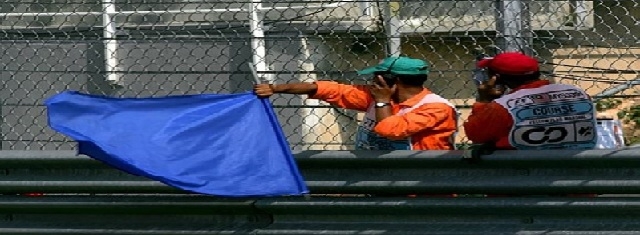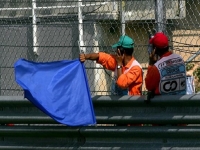Sports
INSIDE FORMULA ONE - NUMBER OF STANDARD FLAGS
UNDERSTANDING F1 RACING

A marshal waves a blue flag (Source: Formula 1 - Formula One World Championship)
USPA NEWS -
The 'formula', designated in the name, refers to a set of rules, to which all participants' cars must conform. The F1 season consists of a series of races, known as Grands Prix (from French, originally meaning great prizes), held throughout the world on purpose-built F1 circuits and public roads...
The 'formula', designated in the name, refers to a set of rules, to which all participants' cars must conform. The F1 season consists of a series of races, known as Grands Prix (from French, originally meaning great prizes), held throughout the world on purpose-built F1 circuits and public roads.
Marshals at various points around the circuit are issued with a number of standard flags, all used to communicate vital messages to the drivers as they race around the track.
Marshals at various points around the circuit are issued with a number of standard flags, all used to communicate vital messages to the drivers as they race around the track.
- Chequered flag
Indicates to drivers that the session has ended. During practice and qualifying sessions it is waved at the allotted time, during the race it is shown first to the winner and then to every car that crosses the line behind him.
- Yellow flag
Indicates danger, such as a stranded car, ahead. A single waved yellow flag warns drivers to slow down, while two waved yellow flags at the same post means that drivers must slow down and be prepared to stop if necessary. Overtaking is prohibited.
- Green flag
All clear. The driver has passed the potential danger point and prohibitions imposed by yellow flags have been lifted.
Indicates to drivers that the session has ended. During practice and qualifying sessions it is waved at the allotted time, during the race it is shown first to the winner and then to every car that crosses the line behind him.
- Yellow flag
Indicates danger, such as a stranded car, ahead. A single waved yellow flag warns drivers to slow down, while two waved yellow flags at the same post means that drivers must slow down and be prepared to stop if necessary. Overtaking is prohibited.
- Green flag
All clear. The driver has passed the potential danger point and prohibitions imposed by yellow flags have been lifted.
- Red flag
The session has been stopped, usually due to an accident or poor track conditions.
- Blue flag
Warns a driver that he is about to be lapped and to let the faster car overtake. Pass three blue flags without complying and the driver risks being penalised. Blue lights are also displayed at the end of the pit lane when the pit exit is open and a car on track is approaching.
- Yellow and red striped flag
Warns drivers of a slippery track surface, usually due to oil or water.
- Black with orange circle flag
Accompanied by a car number, it warns a driver that he has a mechanical problem and must return to his pit.
The session has been stopped, usually due to an accident or poor track conditions.
- Blue flag
Warns a driver that he is about to be lapped and to let the faster car overtake. Pass three blue flags without complying and the driver risks being penalised. Blue lights are also displayed at the end of the pit lane when the pit exit is open and a car on track is approaching.
- Yellow and red striped flag
Warns drivers of a slippery track surface, usually due to oil or water.
- Black with orange circle flag
Accompanied by a car number, it warns a driver that he has a mechanical problem and must return to his pit.
- Half black, half white flag
Accompanied by a car number, it warns of unsporting behaviour. May be followed by a black flag if the driver does not heed the warning.
- Black flag
Accompanied by a car number, it directs a driver to return to his pit and is most often used to signal to the driver that he has been excluded from the race.
- White flag
Warns of a slow moving vehicle on track.
Source : Formula 1
Accompanied by a car number, it warns of unsporting behaviour. May be followed by a black flag if the driver does not heed the warning.
- Black flag
Accompanied by a car number, it directs a driver to return to his pit and is most often used to signal to the driver that he has been excluded from the race.
- White flag
Warns of a slow moving vehicle on track.
Source : Formula 1
Ruby Bird Yasmina Beddou Formula One Racing Flags Pit Stops F1 Circuit Communication Drivers Gps Marshalling System Track
Liability for this article lies with the author, who also holds the copyright. Editorial content from USPA may be quoted on other websites as long as the quote comprises no more than 5% of the entire text, is marked as such and the source is named (via hyperlink).






